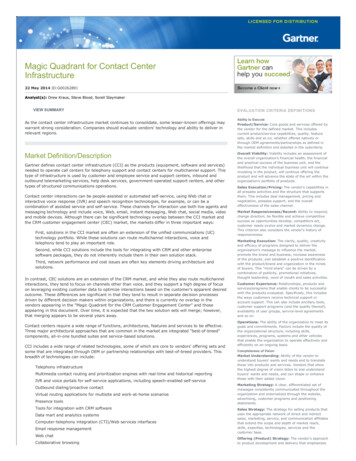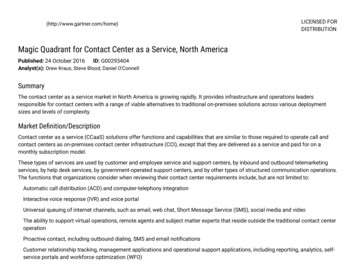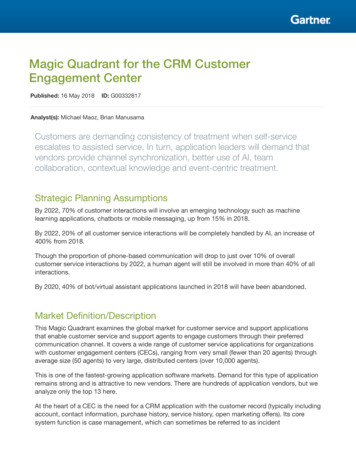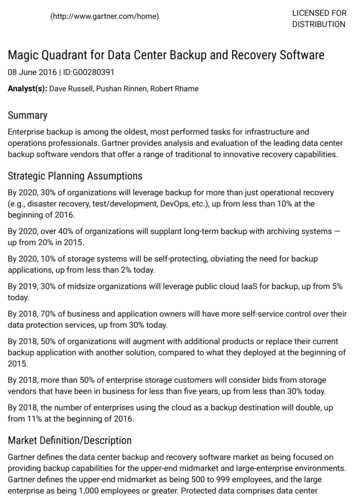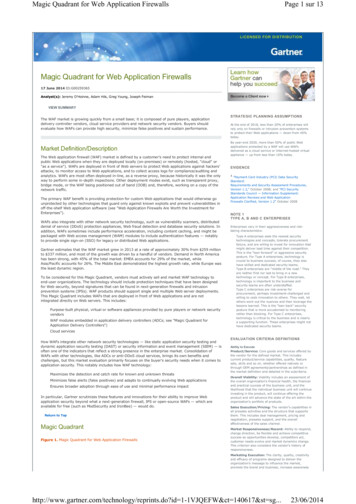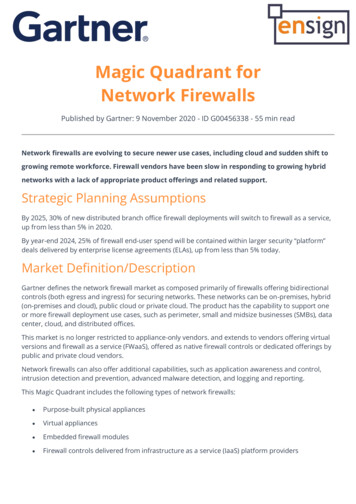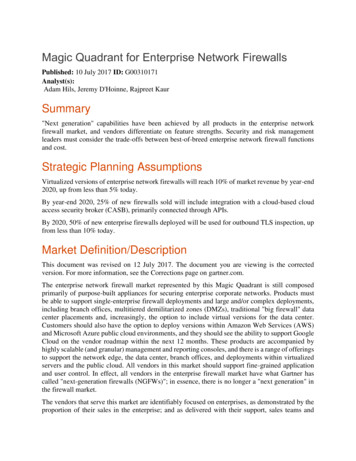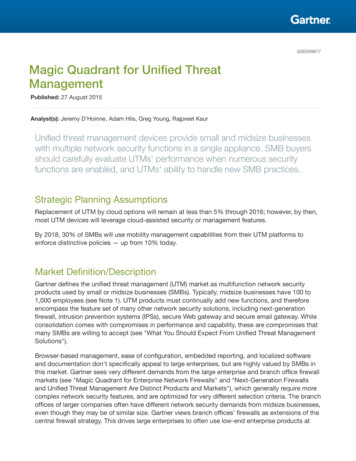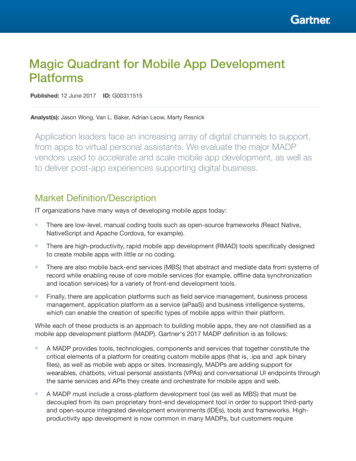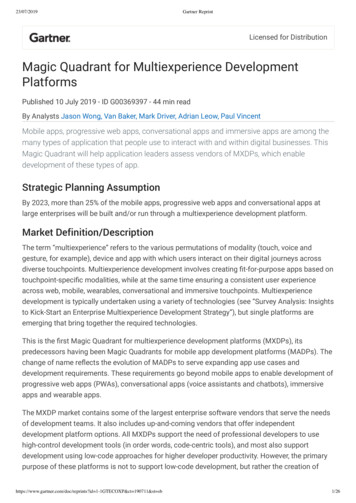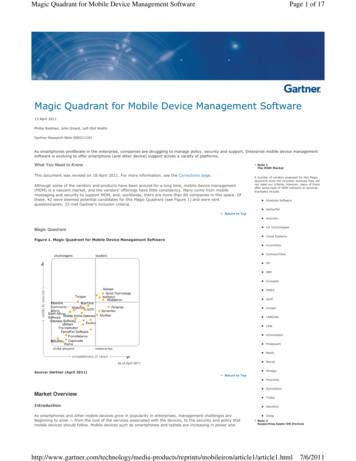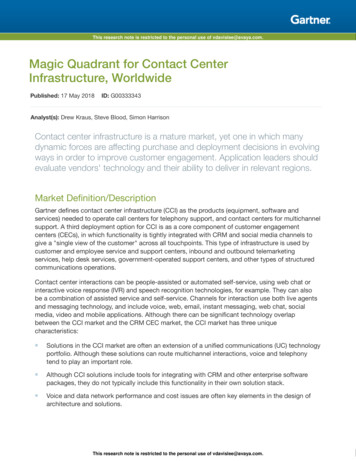
Transcription
This research note is restricted to the personal use of vdavislee@avaya.com.Magic Quadrant for Contact CenterInfrastructure, WorldwidePublished: 17 May 2018ID: G00333343Analyst(s): Drew Kraus, Steve Blood, Simon HarrisonContact center infrastructure is a mature market, yet one in which manydynamic forces are affecting purchase and deployment decisions in evolvingways in order to improve customer engagement. Application leaders shouldevaluate vendors' technology and their ability to deliver in relevant regions.Market Definition/DescriptionGartner defines contact center infrastructure (CCI) as the products (equipment, software andservices) needed to operate call centers for telephony support, and contact centers for multichannelsupport. A third deployment option for CCI is as a core component of customer engagementcenters (CECs), in which functionality is tightly integrated with CRM and social media channels togive a "single view of the customer" across all touchpoints. This type of infrastructure is used bycustomer and employee service and support centers, inbound and outbound telemarketingservices, help desk services, government-operated support centers, and other types of structuredcommunications operations.Contact center interactions can be people-assisted or automated self-service, using web chat orinteractive voice response (IVR) and speech recognition technologies, for example. They can alsobe a combination of assisted service and self-service. Channels for interaction use both live agentsand messaging technology, and include voice, web, email, instant messaging, web chat, socialmedia, video and mobile applications. Although there can be significant technology overlapbetween the CCI market and the CRM CEC market, the CCI market has three uniquecharacteristics: Solutions in the CCI market are often an extension of a unified communications (UC) technologyportfolio. Although these solutions can route multichannel interactions, voice and telephonytend to play an important role. Although CCI solutions include tools for integrating with CRM and other enterprise softwarepackages, they do not typically include this functionality in their own solution stack. Voice and data network performance and cost issues are often key elements in the design ofarchitecture and solutions.This research note is restricted to the personal use of vdavislee@avaya.com.
This research note is restricted to the personal use of vdavislee@avaya.com.In contrast, CEC solutions are most frequently an extension of CRM platforms' case managementand problem resolution capabilities. While these solutions also route multichannel interactions, theytend to focus on channels other than voice, and they support a strong focus on using existingcustomer data to optimize interactions based on the customer's apparent desired outcome. Thesedifferences are significant in that they tend to result in separate decision processes driven bydifferent decision makers within organizations. There is, furthermore, currently little overlap betweenthe vendors appearing in the present Magic Quadrant and those in the "Magic Quadrant for theCRM Customer Engagement Center." Over time, we expect the two solution sets to merge, but thatmerger is still several years off.Contact centers require a wide range of functions, architectures, features and services to beeffective. Two architectural approaches that are common include integrated best-of-breedcomponents and all-in-one bundled suites; either of these approaches can be delivered onpremises or as cloud-based solutions.CCI includes a wide range of related technologies, some of which are central to vendors' offeringsand some integrated through OEM or partnership relationships with best-of-breed providers.Technology areas can include: Voice routing technologies Telephony infrastructure IVR and voice portals for self-service applications, including speech-enabled self-service Outbound dialing/proactive contact Virtual routing applications for multisite and work-at-home scenariosDigital channel routing technologies Multimedia contact routing and prioritization engines with real-time and historical reporting Computer-telephony integration/web services interfaces — including tools for integrationwith CRM software Presence tools Email response management Web chat SMS Collaborative browsing Social media Live and prerecorded video Workflow routing and managementPage 2 of 24Gartner, Inc. G00333343This research note is restricted to the personal use of vdavislee@avaya.com.
This research note is restricted to the personal use of vdavislee@avaya.com. Mobile customer service applications Knowledge-based self-service Sentiment analysisWorkforce engagement management (WEM) technologies Workforce management scheduling tools Session recording and quality monitoring, including speech analytics Data mart and analytics systemsIncreasingly, contact center managers prefer to purchase much, or all, of their CCI from a singlesource as a bundle — in the pursuit of easier and enduring integration, cradle-to-grave integratedreporting and analytics, and easier system management. Therefore, leading CCI vendors offeringcomplete portfolios of solutions, composed of their own products and those of partners and otherstrategic suppliers, are being favored.Single-tenant, hosted/managed, private cloud contact center services and multitenant contactcenter as a service (CCaaS) offerings have entered the mainstream in many market segments.Although this Magic Quadrant focuses on premises-based CCI offerings, a vendor's ability to offerviable private cloud and CCaaS services to customers who may wish to eventually migrate to suchservices positively affects its score on the Completeness of Vision axis. However, a vendor thatexhibits a very strong shift in business strategy — to make private cloud and/or CCaaS its primaryoffering, and to de-emphasize its premises-based solution — may receive a lower score forCompleteness of Vision than previously. For more in-depth coverage of CCaaS services, pleaserefer to "Magic Quadrant for Contact Center as a Service, North America" and "Magic Quadrant forContact Center as a Service, Western Europe."Page 3 of 24Gartner, Inc. G00333343This research note is restricted to the personal use of vdavislee@avaya.com.
This research note is restricted to the personal use of vdavislee@avaya.com.Magic QuadrantFigure 1. Magic Quadrant for Contact Center Infrastructure, WorldwideSource: Gartner (May 2018)Vendor Strengths and CautionsAspect SoftwareAspect Software, a U.S.-based, privately held company, is owned predominantly by GuggenheimPartners, GSO Partners and MidOcean Partners. The company is in the process of recasting itselfPage 4 of 24Gartner, Inc. G00333343This research note is restricted to the personal use of vdavislee@avaya.com.
This research note is restricted to the personal use of vdavislee@avaya.com.as a "cloud first" vendor, offering hosted and/or managed private cloud services as well as itsAspect Via CCaaS service. However, it continues to generate a significant portion of its licenserevenue from its premises-based Unified IP platform. Unified IP offers a unified multimedia contactcenter application suite for midsize and large implementations, including several best-of-breedapplications.Organizations should consider Aspect when there is a need to integrate with multiple IP PBXtelephony environments, or when they want to "decouple" the timing of their contact center andtelephony investment decisions.Strengths Aspect provides well-integrated, best-of-breed functionality in a variety of contributing contactcenter technology areas, including IVR, mobile customer service and web self-service, WEMand outbound dialer. Aspect's ability to integrate with a wide variety of third-party telephony and UC solutionsenables it to support customers that want to consolidate their contact center technology whilemaintaining a decentralized approach to other communications technologies. Aspect is good at delivering solutions to companies that require their systems to be customizedin order to address business-specific needs, including companies that require global coveragefor sales and support.Cautions It is unclear how well Aspect will be able to continue to aggressively fund the development andsupport of its premises-based contact center offerings and cloud offerings in the future. Itsinstalled base and derived service revenue (Aspect's largest source of income) are in decline. Aspect's sales of premises-based solutions are in decline as the company shifts to a cloud-firstbusiness approach. This may lead to a reduced focus on developing and supporting its onpremises offerings. Some Gartner clients consider that Aspect lacks relevance in a market which is moving fromcall and contact centers to CECs. Aspect has, however, made progress in recent years indeveloping its offerings to keep in line with current market trends.AvayaAvaya is a U.S.-based public company. Avaya's core offering is the Avaya Oceana platform, addingadvanced multichannel functionality to its Avaya Aura Call Center Elite (AACCE) voice platform and,eventually, to Avaya Aura Contact Center (AACC) and third-party automatic call distribution (ACD)solutions. The Oceana platform includes Oceanalytics for advanced multichannel reporting andcustomer journey mapping, and the Oceana Workspaces browser-based multichannel agentdesktop interface.Page 5 of 24Gartner, Inc. G00333343This research note is restricted to the personal use of vdavislee@avaya.com.
This research note is restricted to the personal use of vdavislee@avaya.com.Avaya continues to offer and support its existing multiple contact center platforms, each of which isaimed at a different part of the market. AACCE is for large enterprises with a voice-centric customerengagement strategy; AACC, and the Avaya Contact Center Select variant for Avaya IP Office, formidsize multichannel enterprises; Avaya IP Office Contact Center is for small and midsizebusinesses (SMBs). Evolution paths to Oceana are available for existing Avaya customers.Organizations of all sizes with sophisticated call-handling or multichannel requirements shouldconsider Avaya's contact center offerings, which include several best-of-breed applications forcontact center environments.Strengths Avaya has strong brand recognition with large and midsize corporate organizations for CCI. Itsstrong global footprint, including service provider/system integrator (SP/SI) partners, helps it toaddress the needs of most types of organization. Avaya's Oceana multichannel contact center platform offers full digital channel support,context, attribute-based routing, and real-time and historical reporting and analytics. Thisplatform consolidates Avaya's previously fragmented approach to delivering multichannelcontact center functionality. The Avaya Breeze platform (with Avaya Engagement Designer), Zang cloud communicationsplatform and applications "as a service," and Avaya Snap-ins and Snapp Store marketplace,enable developers to quickly create unique communications-enabled contact centerapplications and workflows for within and beyond the enterprise.Cautions Avaya has multiple overlapping product offerings, the rationalization of which createsuncertainties for customers and prospects considering upgrades or new investments in existingplatforms. Customers and prospects should ask to see development roadmaps for Avayasolutions that extend through the expected life of that investment. Avaya is in the early stages of incorporating its newly acquired CCaaS offering. At the time ofwriting, this does not include support for the company's Oceana functionality. This createsdiscontinuities for companies wanting to pursue a hybrid on-premises and CCaaS deployment. A number of Gartner clients continue to express dissatisfaction with Avaya's ability toimplement and support contact center solutions, although Avaya has made recent investmentsand organizational changes in an effort to address this. The issue is, potentially, exacerbated byAvaya's channel partners moving toward being multivendor — thereby challenging theircontinued excellence in supporting Avaya's portfolio.CiscoCisco is a U.S.-based public company. Its contact center offerings lead with Packaged ContactCenter Enterprise (PCCE), targeting implementations of up to 2,000 seats. Unified Contact CenterExpress is for small and midsize contact centers with fewer than 400 agents and Unified ContactPage 6 of 24Gartner, Inc. G00333343This research note is restricted to the personal use of vdavislee@avaya.com.
This research note is restricted to the personal use of vdavislee@avaya.com.Center Enterprise (UCCE) is for large enterprises and those requiring advanced functionality. Acloud-based variant of CCE is also available through select channel partners on Cisco's HostedCollaboration Solution platform. The recent acquisition of BroadSoft complements Spark Care(Cisco's customer support capability within the company's Spark workstream collaboration offering)with CC-One, a larger, more robust cloud-based contact center platform hosted by Cisco.Organizations that favor an end-to-end network, telephony, UC and contact center solution from asingle vendor should consider Cisco's contact center offerings, especially those companies withadvanced and scalable contact center requirements.Strengths Cisco has strong finances, corporate brand recognition and a robust global network of channelpartners. As a result, it is frequently shortlisted by organizations looking to replace orconsolidate legacy contact center investments. The acquisition of BroadSoft, and with it the CC-One CCaaS platform, positions Cisco stronglyin both infrastructure and communications services. The two vendors have a complementaryecosystem of partners. Cisco is strengthening its proposition around multichannel and outbound communication —with deeper integration to CRM applications, through its Finesse desktop, and its extension intovertical desktop applications starting with healthcare.Cautions Cisco relies largely on partners to deliver contributing contact center functionalities such asWEM and knowledge management — at a time when the industry is witnessing consolidation inthese areas. Acquisition of partners by competitors could result in disruption to existingpartnerships and portfolio management. Organizations committed to using Microsoft's Skype for Business as a UC platform do not havea practical path for integration with a Cisco-based contact center platform. Discussions with users of Gartner's client inquiry service, together with evidence from GartnerPeer Insights, indicate that Cisco's UCCE and PCCE platforms rate well for product capabilities,but less well for pricing and contract flexibility and for management and integration capabilities.Enghouse InteractiveEnghouse Interactive is a division of Enghouse Systems, a public company based in Canada. Thecompany has refocused its sales and development efforts into two primary contact center offerings.Communications Center (CC) targets small and midsize contact centers, either on-premises ordelivered through a hosted managed service, especially for integration with a number of PBXs(including with Skype for Business). This solution is sold exclusively through channel partners. Thesecond offer, Contact Center: Service Provider (CCSP) is a cloud-based multitenant platform aimedat service providers that offer CCaaS solutions. In addition, Contact Center: Enterprise (CCE)Page 7 of 24Gartner, Inc. G00333343This research note is restricted to the personal use of vdavislee@avaya.com.
This research note is restricted to the personal use of vdavislee@avaya.com.targets high-end enterprise premises-based contact center environments and virtualized cloudenvironments. While CCE is still sold and supported for specific opportunities with requirements forenterprise scale or high resiliency, the company will reduce the sales focus on it in future.Enghouse owns four other discrete but related technology providers: Trio Enterprise, Voxtron, Reitekand Presence Technology.Consider Enghouse CC when looking for a multichannel contact center solution for fewer than 500agents and where you need to tightly integrate with a Microsoft Skype for Business Serverinfrastructure.Strengths Enghouse Interactive's parent company, Enghouse Systems, is committed to a strategy forgrowth through acquisition. This supports growth in Enghouse Interactive and the addition of abroader contact center portfolio, including speech analytics and WEM. Enghouse has clarified its go-to-market plan for its core contact center offerings, which shouldmake it easier for organizations to identify the most appropriate solution for their needs. Enghouse's channel partners have a large installed base for integrations of CC with Microsoft'sSkype for Business infrastructure, which is useful for organizations looking for referenceexamples for a planned integration.Cautions The narrowed sales focus for CCE raises concerns that R&D and support may be at risk in thelong term. The Enghouse CC architecture relies heavily on integration with its competitors' IP PBXplatforms for delivery of voice to the desktop. Although this enables contact center migrationacross PBXs, the approach can be less palatable for those looking to obtain both CCI and UCfrom a single provider. Enghouse pursues an acquisition strategy in order to promote organizational growth. Theacquisition of smaller, discrete players can provide value-added components for the portfolio,but may create uncertainty in the development roadmap for these offerings as they compete ina market increasingly dominated by larger vendors.GenesysGenesys is a privately held company based in the U.S. and with major private equity investmentfrom Permira and Hellman & Friedman. Genesys has three primary offerings in this market.PureEngage is offered on-premises or as a private cloud platform and supports contact centers withhundreds or thousands of agents, particularly those with complex customization requirements.PureConnect is offered on-premises or as multi-instance CCaaS, supporting contact centersoperating up to several hundred agents, particularly for customers with moderately complex needswho value a tightly integrated all-in-one platform. PureCloud is a microservices-based, multitenantPage 8 of 24Gartner, Inc. G00333343This research note is restricted to the personal use of vdavislee@avaya.com.
This research note is restricted to the personal use of vdavislee@avaya.com.CCaaS offering, typically operating with contact centers of up to 250 agents for customers whovalue cloud-based, easy-to-deploy functionality and require only basic customization.Consider Genesys for contact center solutions that span a variety of levels of complexity andscalability, including those that require significant customization to deliver differentiated customerservice.Strengths Genesys has a well-defined approach for decoupling contact center applications fromtelephony infrastructure across a wide range of contact center sizes, levels of complexity anddegrees of customization. The company's acquisition of Altocloud will enhance its portfolio with machine learningcapabilities for predictive engagements based on customer journey analytics. Genesys PureConnect and PureCloud provide a common set of application development,management and reporting tools across a range of applications. These all-in-one offeringsresonate strongly with decision makers in SMBs.Cautions The lack of a consistent code base across the Genesys product lines makes it challenging forsmall or midsize customers that are facing rapid expansion in size and complexity in order toevolve and grow their investment. Some Gartner clients report frustrations about the skills levels of the Genesys resourcesproviding support for its PureConnect and PureCloud offe
May 17, 2018 · Magic Quadrant for Contact Center Infrastructure, Worldwide Published: 17 May 2018 ID: G00333343 Analyst(s): Drew Kraus, Steve Blood, Simon Harrison Contact center infrastructure is a mature market, yet one in which many dynamic forces are affecting purchase and deployment decisions in evolving ways in order to improve customer engagement.
